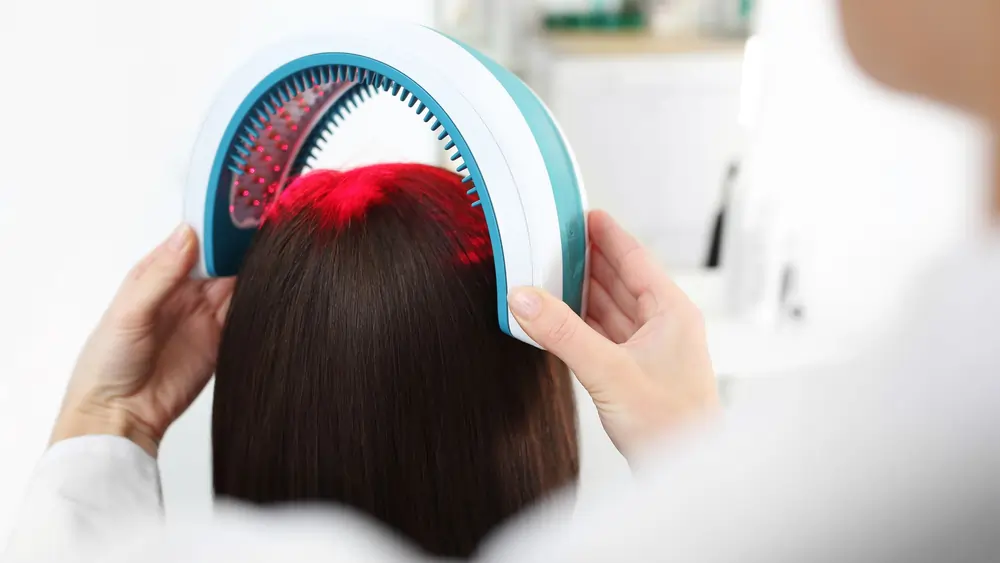Male pattern baldness, which is the most frequent cause of hair loss in men, can begin at a young age. Usually by the age of fifty, well over 50% of males show visible male pattern hair loss, such as a notable thinning, receding hairline, and balding.
Causes of Male Pattern Baldness
Genetics, or having a family history of baldness, is one factor that contributes to male pattern baldness. Male sex hormones also known as androgens has been linked in studies to male pattern baldness. Controlling hair growth is just one of the many functions of androgens.
There is a growth cycle for each hair on your head. With male pattern baldness, the hair follicle contracts and this development cycle starts to weaken, resulting in the production of shorter and thinner hair strands. Every hair’s development cycle ultimately reaches its end, and no further hair can develop in its place.
Male pattern baldness that is inherited typically has no negative effects. Regrettably, more serious illnesses like some malignancies, medicines, thyroid issues, and anabolic steroids can also contribute to baldness. If you experience hair loss after starting a new drug or if it is accompanied by other health issues, consult a doctor.
Male pattern baldness is identified by a doctor based on the pattern of hair loss. To rule out specific medical illnesses as the reason, such as nutrition abnormalities or scalp fungus conditions, physicians may conduct a medical history and exam.
Other causing factors that could cause male pattern baldness are:
- Smoking
- Excessive drinking
- Diet
- Stress
- Poor sleeping patterns
- Certain medications
Symptoms of Male Pattern Baldness
An identifiable pattern of male pattern baldness is brought on by androgenic alopecia. Dihydrotestosterone (DHT), a hormone, destroys the hair follicles and causes the condition. Balding frequently starts in your youth and usually occurs gradually. You might have bald spots by the middle of your life.
Early signs of male pattern baldness include:
- Early signs of a receding hairline.
- As hair loss intensifies, the crown of the head develops bald areas.
- As the hair loss continues, there is hair loss all over the head.
If your hair is thinning, you might notice some of the following signs:
- More than 100 hairs fall out every day.
- Appearance of thinner or more fragile hair.
Psychological Effects of Male Pattern Baldness
A males confidence may suffer greatly if they lose their hair. All men want to look and feel their best, and baldness can get in the way of this even if some guys are more concerned with appearance than others.
Male pattern baldness and poor self-esteem are problems that must be managed with the aid of medical experts. The best option is to get assistance from a counsellor if a man is having severe self-esteem issues as a result of male pattern baldness. Self-esteem is a difficult thing to change, and we can benefit from expert aid in achieving that sort of progress.
It’s important to remember that there are treatments for hair loss even if none of us can choose whether or not we will lose our hair. The effects of baldness therapies on males who have male pattern baldness are very astonishing.
Male Pattern Baldness Progresses Differently From Natural Hair Loss.
The cycles that your hair roots go through include times when the hair itself is shed. Approximately 50 to 100 hairs come out every day as part of the natural hair loss cycle, which is followed by the roots of a new hair growing back. Dihydrotestosterone damages hair roots, contributing to male pattern baldness, which results in:
- Much more hair is falling out than usual.
- When hair does develop, it is thin, discoloured, and fragile.
- A slowing down of the rate of hair growth.
Can Male Pattern Baldness Be Reversed?
Male-pattern baldness has no known treatment, but some drugs can lessen the rate of hair loss. Some men can develop new hair by using the FDA-approved over-the-counter drug minoxidil, which can be applied topically or taken orally. The FD has also approved finasteride as an oral hair loss therapy. These therapies must be used consistently since if you stop using them, your hair loss may reappear.

Methods For Addressing Male pattern Baldness
Many people can halt or slow down hair loss in men and in some circumstances, even regenerate hair by using the scientifically proven hair loss solutions listed below.
Hair styles
With the correct haircut or hairdo, men with minor hair loss can occasionally mask it. Consult your hairstylist to give your thinning hair a unique cut that will make it appear thicker.
Hairpieces
Hairpieces can conceal baldness completely as well as thinning hair as well as receding hairlines. They are available in a range of designs, hues, and textures. Choose hairpiece colours, styles, and textures that resemble your real hair for a more natural appearance.
Finasteride
An oral drug called finasteride can slow several men’s hair loss. It functions by preventing the synthesis of the male hormone that causes hair loss. Compared to minoxidil, finasteride does indeed have a greater success rate. Hair loss resumes when you stop taking finasteride.
Before you see improvements, you must take finasteride for three months to a year. Within a year, if there is no hair growth, your specialist would probably advise you to discontinue the medication entirely.
The following are some finasteride side effects:
- Itching
- Rash
- Depression
- Hives
- Breast tenderness
- Swelling
The PSA tests that are used to screen for prostate cancer may be affected by finasteride. Lower-than-normal values are brought on by the medication’s reduction of PSA levels. While consuming finasteride, any increase in PSA readings should prompt a prostate cancer evaluation.
Minoxidil
A topical drug called minoxidil (Rogaine) is administered to the scalp. For several men, minoxidil slows hair loss and encourages the growth of new hair follicles. It can take between four months and a year for minoxidil to show results. Frequently, hair loss returns when you stop using the medicine.
Dryness, irritability, burning, and scaling of the scalp are among the possible adverse reactions of minoxidil. If you experience any of these severe side effects, you need to see a doctor right away:
- Abdomen, face, ankles, and hands swelling.
- Weight gain.
- Rapid heartbeat.
- Trouble breathing.
- Laboured respiration.
- Chest pain.
LLLT device
It may appear like science fiction to apply a laser wand to your head in order to regrow hair, but reputable scientists claim it is possible. The FDA has approved the use of low-level laser therapy (LLLT) to address hair loss. These gadgets, which have an ongoing red LED light, can be worn as a cap or as a wand that you point at your scalp. According to research, LLLT may cause the stem cells in hair follicles to proliferate and promote the development of new hair.
Minerals and vitamins
There are many vitamin and nutritional supplements on the market that promise to increase hair growth, thickness, or shine, but aside from two prominent exceptions, there isn’t much solid proof that most vitamins and minerals can stop hair loss.
When skin is exposed to direct sunlight, the body generates vitamin D. Furthermore, it is found in foods like milk and eggs. However, a lot of us don’t consume adequate vitamin D. You might wish to get your vitamin D level evaluated by a doctor if you have thinning hair.
Iron is a mineral that individuals acquire through their diets, particularly through foods like red meat or spinach. A prevalent condition is iron deficiency, which affects women more than males. You can become anaemic if you don’t get enough iron (when you have low blood cell counts). Your doctor can examine your iron levels as well.
DHT Blocking Shampoo
The ramifications of DHT on hair follicles are allegedly blocked by a number of shampoo kinds. Though some people do not believe them to be as effective as minoxidil or finasteride, they can work. Ketoconazole is a component in a variety of these shampoos (the active ingredient in the dandruff shampoo Nizoral). Researchers believe that ketoconazole can prevent DHT from harming hair follicles when used in conjunction with other hair loss therapies like finasteride.
PRP treatment
This method, also referred to as “platelet-rich plasma,” entails drawing blood, spinning it in a centrifuge to separate the plasma, and injecting the plasma into the scalp. According to the belief, platelets’ growth factors could promote hair development. Studies demonstrate that PRP treatments, whether used on their own or in conjunction with other hair loss treatments, can boost hair growth.
Hair transplant
Surgery for hair transplants is a fairly popular alternative to hair loss medications. FUE (Follicular Unit Excision) hair transplants are among the most widely used hair transplant techniques.
During a FUE hair transplant, the physician extracts single hair follicles from donor locations on the scalp using specialised equipment that punctures the scalp. On the scalp, the procedure causes scars that are smaller than a millimetre in diameter. After your hair has partially grown out around these scars, this scarring won’t be obvious. The affected hair loss area is subsequently treated with the transplanted hair follicles.
Due to the minimal scarring and quick (usually under 2 weeks) recovery, FUE hair transplants are growing in popularity, and is considered the best option for male pattern baldness.
Tips to Slow Down The Process of Male Pattern Baldness
Your hair is a living organ. For vitality, a healthy blood supply, oxygen, minerals, and vitamins are necessary. Because of this, eating a balanced diet is crucial. You may also add B vitamins, zinc,biotin, and selenium to your diet to help with hair development.
- Avoid using possibly hazardous “heavy” products on your hair.
- Protect your hair from direct sunlight by wearing a hat.
- Avoid using straighteners and hairdryers at high temperatures.
- Stress and smoking are two well-known lifestyle variables that contribute to male pattern balding.
Are There Any Risks to Male Pattern Baldness?
Male pattern baldness often doesn’t indicate a major medical issue, although it has been connected to a number of other problems, including diabetes,high blood pressure, obesity, coronary heart disease, an enlarged prostate or prostate cancer.
Keep track of the pattern and amount of hair loss if you start to notice it happening. To rule out a more serious issue, speak with your doctor.
When Should I Contact My Doctor?
If any of the following apply to you rapid hair loss, extensive shedding, patchy hair loss, or hair breakage call your general practitioner immediately. Itching, skin sensitivity, redness, scaling, soreness, and other symptoms may accompany your hair loss. After starting medication, you start losing your hair.

Other Types of Hair Loss
Alopecia is a condition that causes hair loss when the body’s normal cycle of hair growth is disturbed. Hair loss can take place anywhere on the body, though it appears to happen most often on the scalp. On each scalp, there are 100,000 hairs that go through cycles of growth, rest, shedding, and regeneration. Other types of hair loss:
- Androgenetic Alopecia: Androgenetic alopecia is the primary cause for hair loss, that also affects more than 50 million men and 30 million women worldwide. Male or female pattern hair loss, also known as androgenetic alopecia, is inherited however it is addressed with medication or surgery.
- Telogen Effluvium: When lots of hair follicles on the scalp enter the telogen phase, it results in telogen effluvium, another disorder, or rest phase, of the hair-growing cycle but the succeeding growth phase has not started. This can lead to severe scalp hair loss due to the fact that there is no new hair growth.
- Anagen Effluvium: Accelerated hair loss because of medical interventions like chemotherapy is known as anagen effluvium. These strong, quick-acting drugs destroy cancer cells, but they may also stop the growth of hair follicles on the scalp and in other areas of the body. Hair will often regrow naturally when treatment is finished. Dermatologists can prescribe drugs to hasten the growth of new hair.
- Alopecia Areata: Due to the autoimmune nature of alopecia areata, the immune system of the body assaults healthy tissues, including the hair follicles. This stops new hair from sprouting and leads to hair loss. Hair loss can start quickly and without indication with this illness, which can affect both adults and children. Usually, scalp hair loss occurs in small patches and is painless. It’s possible for hair to fall out on other regions of the body.
- Tinea Capitis: Tinea capitis, often known as scalp ringworm, is a scalp fungal infection that frequently results in hair loss in young children. This disorder results in bald spots that may enlarge over time. Hair loss occurs in patches, often in circular patterns.
- Cicatricial Alopecia: Scarring alopecia, also known as cicatricial alopecia, is an uncommon kind of hair loss wherein the scar tissue grows in their place after inflammation damages the hair follicles. Hair will not grow back when scar tissue has formed.




